We show you the best things to see and hidden places to visit in Pompeii. As every corner is steeped in history, we provide detailed itineraries to suit your needs.
Why does Pompeii matter so much? Because the city offers something no history book can: an unfiltered snapshot of how Romans actually lived, worked, loved, and died.
You’ll find everything here, the Forum where political debates echoed through marble colonnades, the Amphitheatre where 20,000 spectators roared at gladiatorial combat, luxurious homes decorated with mosaics worth millions, and even a commercial brothel whose walls tell stories in explicit detail. Whether you have a few hours or a full day, Pompeii rewards every moment you spend.
Look, Pompeii covers roughly 66 hectares (that’s about 163 acres), and you could spend weeks exploring every corner. But if you’re working with limited time (and most of us are) there are certain spots you absolutely cannot miss. These eight highlights represent what made Pompeii extraordinary.
Stand in the Forum, and you’re standing at the crossroads of everything that mattered in Roman Pompeii. The Forum was the city’s commercial, political, and religious core.
Picture it: merchants hawking goods under colonnaded porticos, lawyers arguing cases in the Basilica, priests making offerings at multiple temples, citizens gathering to hear official announcements.
What makes the Forum truly special is how it tells Pompeii’s cultural evolution in architecture. The Temple of Apollo, with origins reaching back to the 6th century BC, speaks to the city’s Greek roots. Later, the massive Temple of Jupiter was built to dominate the northern end, a stone declaration that Rome was now in charge. You’ll even find the Temple of Isis here, dedicated to an Egyptian goddess (proof that Pompeii was a cosmopolitan melting pot where Eastern mystery cults found enthusiastic followers).
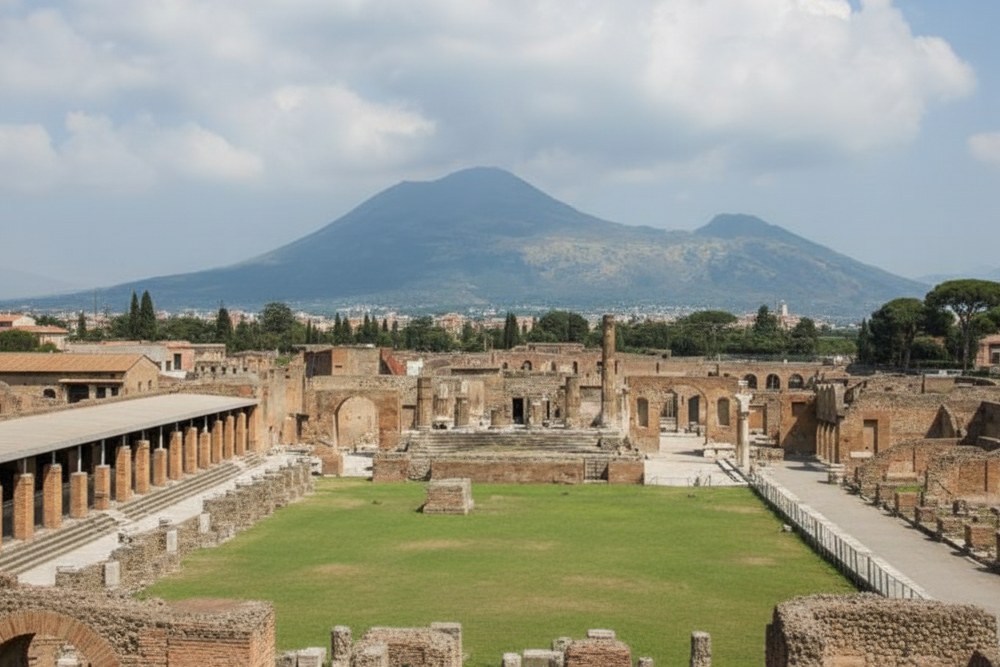
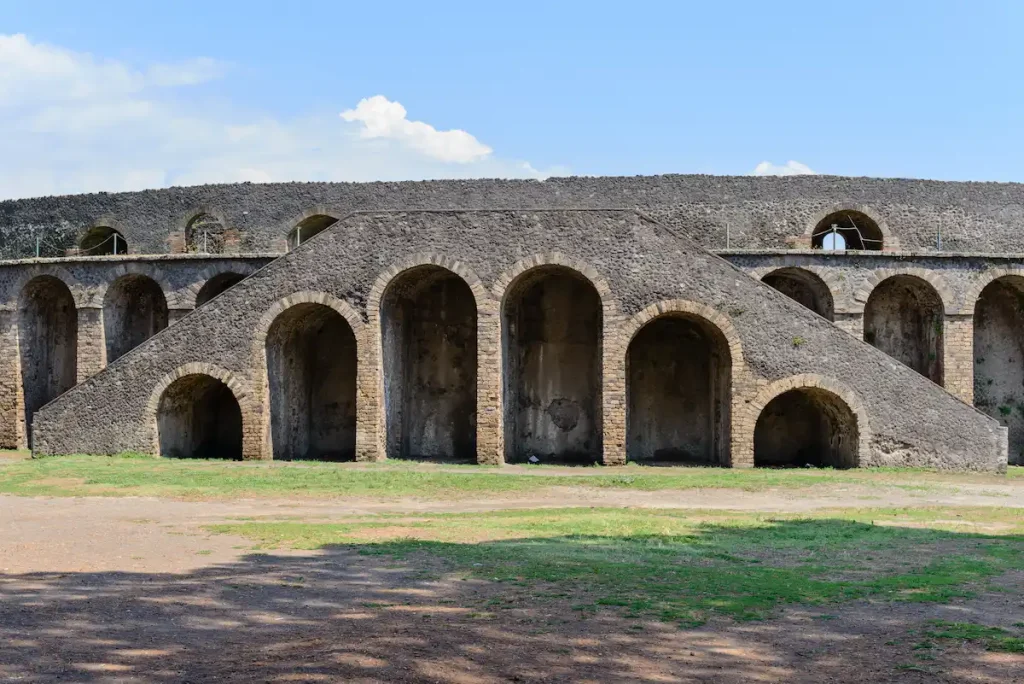
Walk to the southeastern edge of the city, and you’ll encounter the oldest stone-built Roman amphitheatre still standing. Built around 70 BC, this arena predates Rome’s famous Colosseum by more than a century.
The amphitheatre was where Pompeians came to watch their version of reality TV: gladiatorial combat. These weren’t just mindless bloodbaths (though they were certainly bloody). Gladiators were celebrities, their names and victories scratched into walls with the kind of fervor modern fans reserve for rock stars. One bit of graffiti calls the Thracian fighter Celadus “the heartthrob of the girls.”
But the amphitheatre’s most infamous moment had nothing to do with planned entertainment. In 59 AD, a gladiatorial show descended into a massive riot between Pompeian fans and visitors from the rival town of Nuceria. What started as shouted insults turned into a full-scale brawl with stones and swords. The violence was so severe that Emperor Nero imposed a ten-year ban on all games as punishment. A vivid fresco found in a nearby house captures the chaos.

Step through the entrance of this massive residence, and you’re entering the private world of Pompeii’s ultra-elite. Occupying an entire city block at 3,000 square meters, the House of the Faun was a statement of power, wealth, and cultural sophistication.
The real showstopper is the Alexander Mosaic, originally laid in the floor of a formal reception room. This masterpiece depicts the pivotal moment when Alexander the Great defeated the Persian King Darius III at the Battle of Issus in 333 BCE. You can see the panic in Darius’s eyes as he flees, the determination in Alexander’s charge, even a fallen soldier watching his own death reflected in his shield.
The house was essentially a private museum, using art to broadcast the owner’s elite status to every visitor who crossed the threshold. (The original mosaic is now safely displayed at the Naples Archaeological Museum, while a replica marks its original location.)
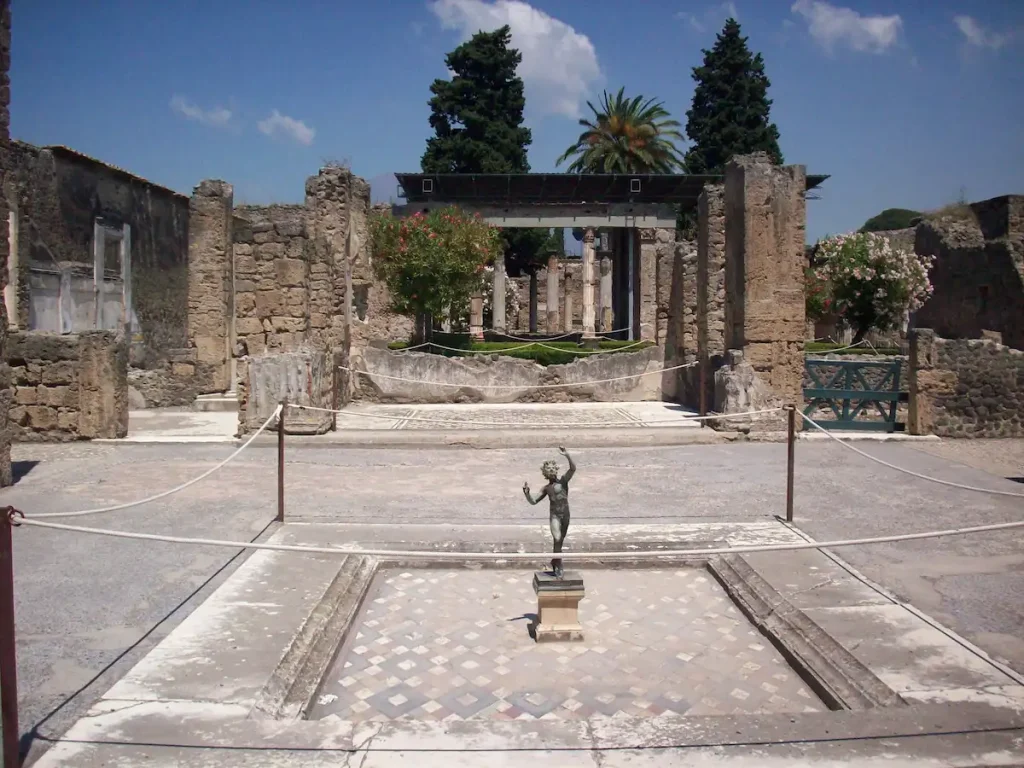
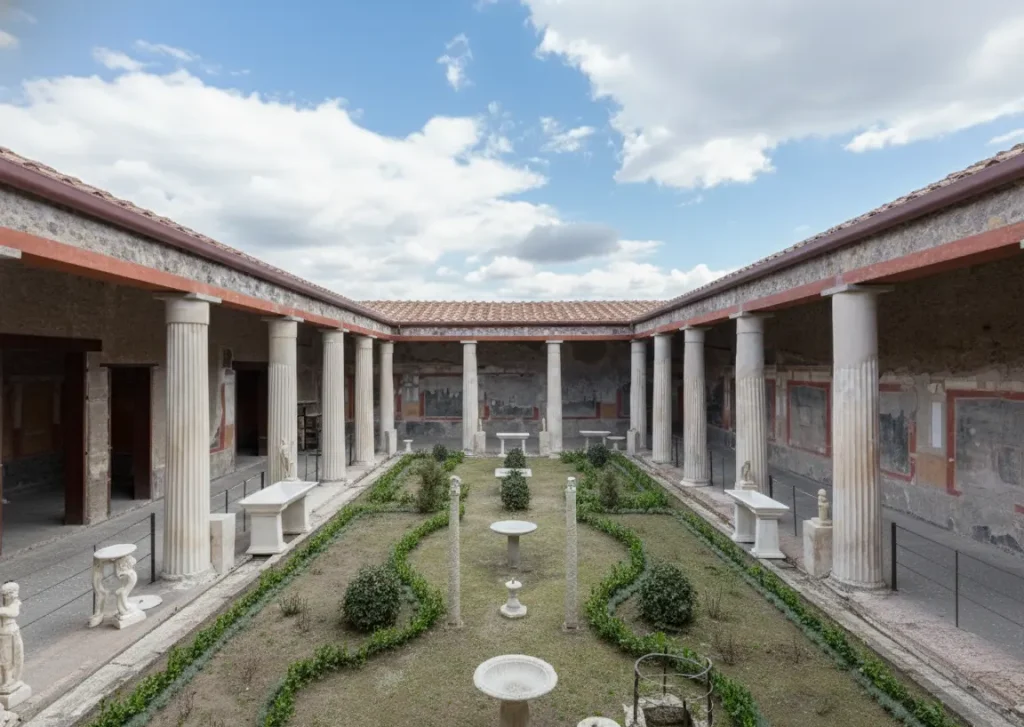
Here’s where Pompeii’s story gets really interesting. The House of the Vettii belonged to two brothers, Aulus Vettius Conviva and Aulus Vettius Restitutus, who were freedmen (former slaves) who’d made it big, probably in the wine trade. After the devastating earthquake of 62 AD drove many old aristocratic families out of Pompeii, ambitious entrepreneurs like the Vettii brothers rushed in to fill the vacuum.
You’ll know you’re in “new money” territory the moment you enter. The vestibule features a massive fresco of the god Priapus weighing his enormous erect phallus against a bag of coins. While phallic imagery was common in Pompeii as a good-luck charm, this version is unusually explicit and commercial. The brothers are literally equating their masculine power with their financial success.

Let’s talk about Pompeii’s most famous brothel. The Lupanar sits at the intersection of two side streets, and it’s the only building archaeologists can identify with certainty as a purpose-built, commercial brothel.
What makes the Lupanar fascinating isn’t the building itself, it’s what’s written on the walls. Over 150 graffiti inscriptions were scratched into the plaster by both clients and the prostitutes themselves.
The Lupanar is a reminder that Roman society, for all its architectural genius and artistic achievement, was built on profound inequality. But those graffiti inscriptions? They give voice to people history usually silences, making this one of the most human places in all of Pompeii.
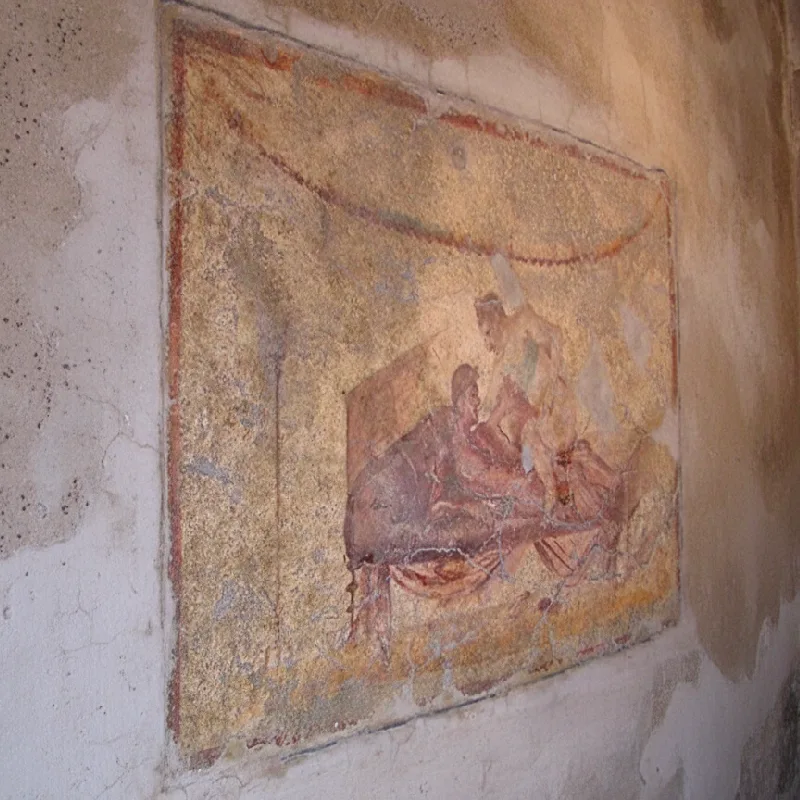
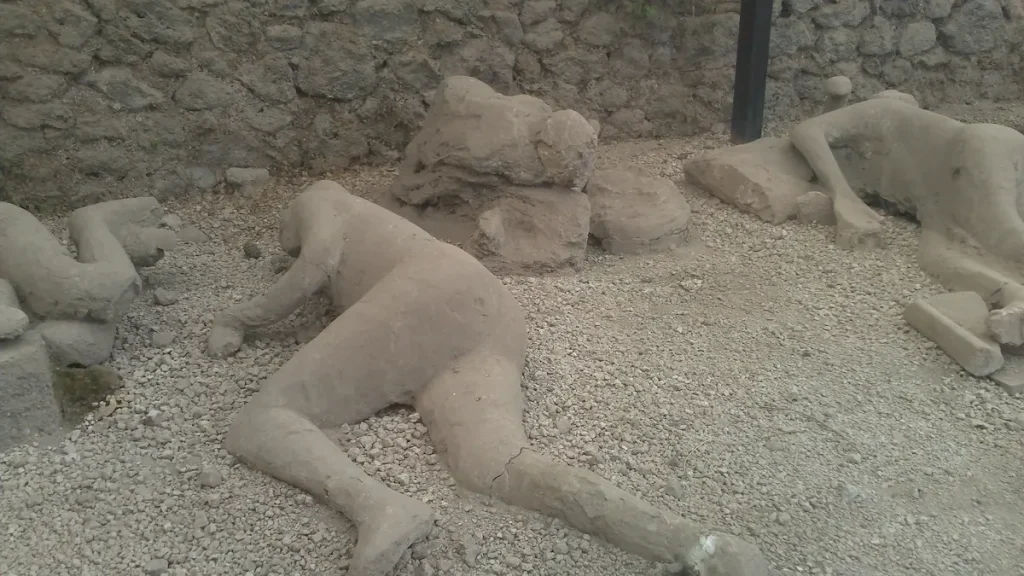
This is where Pompeii stops being an archaeological marvel and becomes heartbreakingly real. In a corner that was once a vineyard, thirteen plaster casts lie in glass cases, preserving the exact positions of victims caught in their final moments. You’ll see families huddled together, individuals collapsed mid-flight, their faces frozen in expressions of terror or resignation.
These casts exist thanks to a brilliant technique developed in 1863 by excavation director Giuseppe Fiorelli. When excavators found hollow cavities in the hardened ash, Fiorelli realized these voids were molds left by decomposed bodies. By pouring liquid plaster into the cavities, he could capture the victims’ exact postures, clothing folds, and facial expressions at the moment of death.
The thirteen people in the Garden of the Fugitives were found lying on top of the pumice layer from the eruption’s first phase, meaning they’d survived the initial bombardment. Their location near the Nocera Gate suggests they were making a desperate run for safety when a pyroclastic surge overtook them.

Dating back to the 2nd century BC, the Stabian Baths are the oldest and best-preserved public bathhouse in Pompeii. But don’t think of these as just a place to get clean. The baths were the ancient Roman equivalent of a community center, gym, spa, and social club rolled into one. Since most Pompeians lacked private bathing facilities at home, a daily trip here was essential—not just for hygiene but for networking, gossip, exercise, and relaxation.
The bathing ritual followed a specific health-oriented sequence. You’d start in the apodyterium (changing room), then move through progressively hotter rooms: the warm tepidarium, the hot caldarium for sweating and hot baths, and finally a bracing plunge in the cold frigidarium. The complex also featured a large courtyard, or palaestra, for wrestling and exercise, plus a swimming pool.
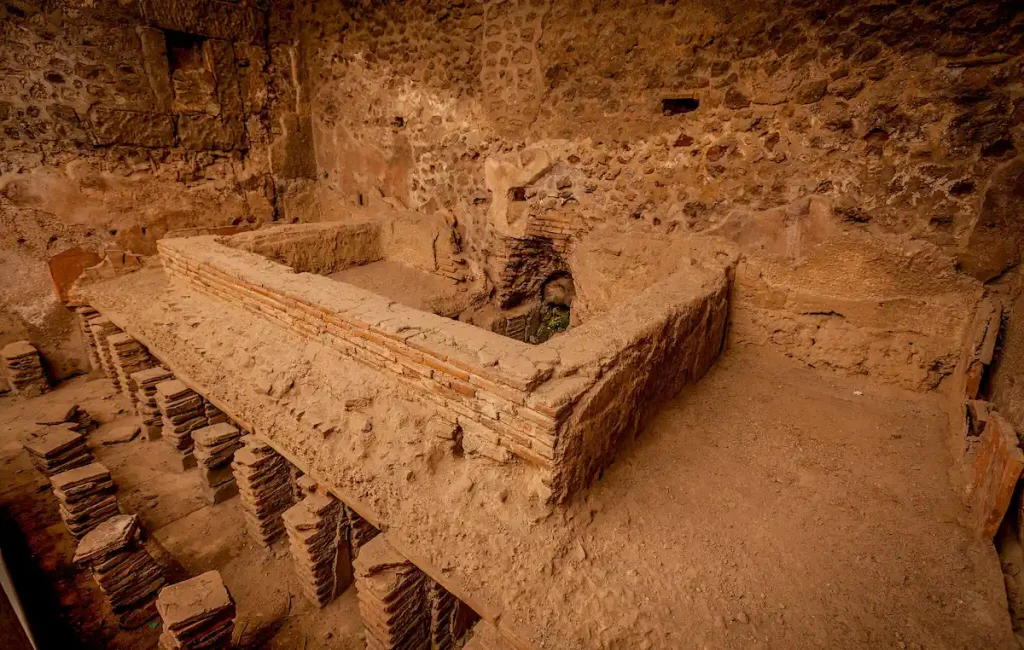
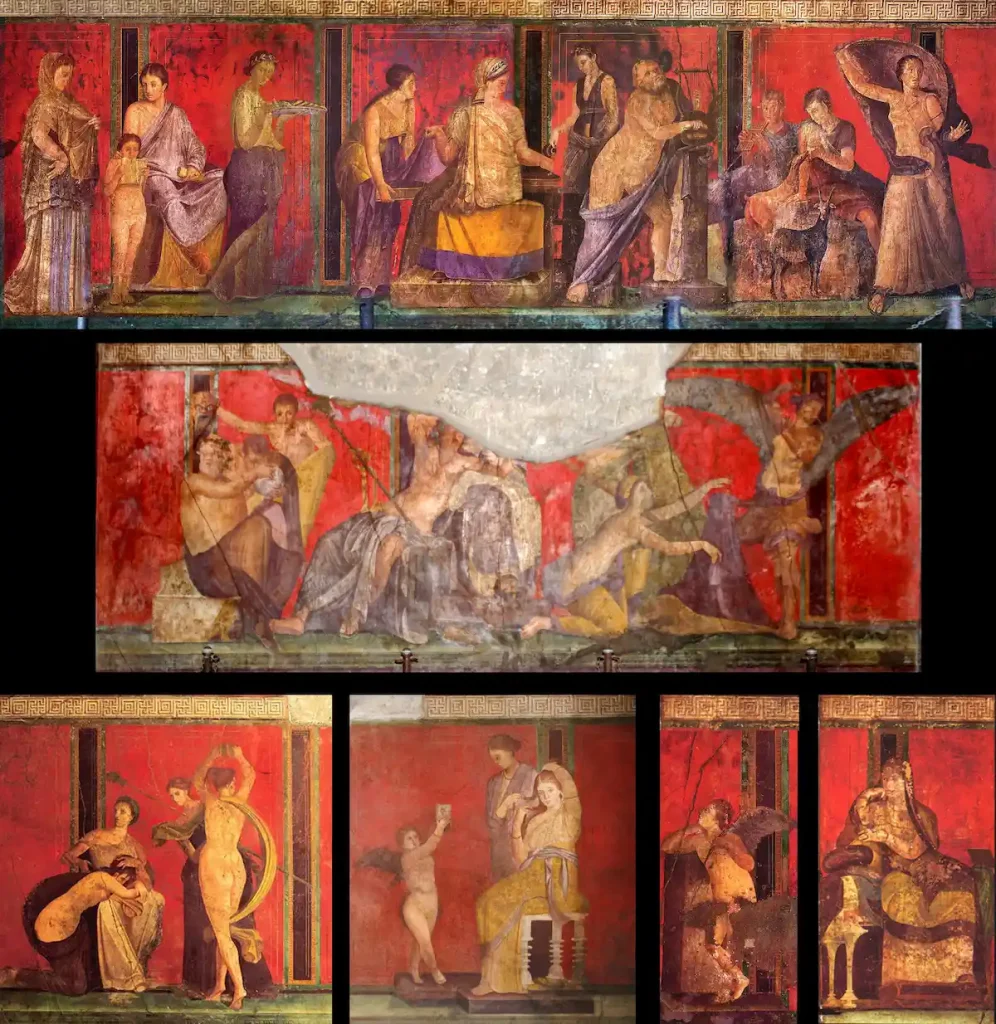
The Villa of the Mysteries was a luxurious suburban estate combining aristocratic leisure with practical farming. But what draws visitors is a single room covered in nearly life-sized figures painted against a luminous “Pompeian red” background.
These frescoes have puzzled scholars for over a century. The most accepted interpretation is that they depict a woman’s initiation into the Dionysian Mysteries, a secret cult devoted to Dionysus (the god of wine, fertility, and ecstasy). Unlike formal state religion, mystery cults offered personal, emotional spiritual experiences and promised initiates special knowledge and benefits after death.

Once you’ve hit the major highlights, don’t rush for the exit. Pompeii rewards those who wander beyond the well-trodden paths. These lesser-known spots won’t have the tour group crowds, which means you can take your time and really absorb what you’re seeing.
POMPEII TICKETS
TOURIST INFORMATION
POMPEII INFORMATION
Nestled in the shadow of the mighty Mount Vesuvius, Pompeii’s location is as dramatic as its history. This ancient Roman city, now a UNES… see more
Pompeii’s after-dark allure centers on meticulously curated seasonal programs that grant special access to the archaeological park. These typically run during the warmer months, primarily from July through October, focusing on weekend evenings (Fridays and Saturdays) with visiting hours usually from 8:00 PM to 11:00 PM or 11:30 PM. The last entry is generally around 10:00 PM, so don’t cut it close.
The nocturnal routes showcase some of Pompeii’s most spectacular areas: the magnificent Villa of the Mysteries, the grand public space of the Forum, the well-preserved Stabian Baths, the luxurious Praedia of Julia Felix, and the stunningly frescoed House of the Venus in the Shell. These aren’t random choices, they’re carefully selected spots that take on an entirely different character when experienced in low light and complete tranquility.
Beyond atmospheric walks, Pompeii’s evening programs transform its ancient spaces into living venues for contemporary art. A standout example is “POMPEII. VOX FEMINAE – The Secret Words of Women“, a theatrical series celebrating the lives of Pompeian women through a blend of theater, narration, and live music.
Let’s be honest: you’re not flying halfway around the world just to see Pompeii and then head straight home. The Bay of Naples region is packed with extraordinary sites, and the smart move is to combine several into a journey that tells the complete story of this volcanic landscape and its 2,000-year relationship with humanity.
Why visit both Pompeii and Vesuvius? Because seeing the city without confronting the mountain that killed it leaves the story incomplete. Pompeii shows you the aftermath and Vesuvius shows you the cause. Standing on the crater rim, staring into the 450-meter-wide, 300-meter-deep volcanic mouth where steam still rises from fumaroles, gives you the physical reality behind the abstract historical event.
The most popular route is Path N. 5, “The Gran Cono”, which leads directly to the crater rim. The walk offers panoramic views of the Bay of Naples, the Sorrento Peninsula, and the sprawling modern city below.
Visiting both sites in one day is entirely feasible. Most people recommend seeing Pompeii first ,spending the morning and early afternoon walking the ancient streets, then heading to Vesuvius for the late afternoon climb. This timing gives you two advantages: the hike is cooler, and you’ll potentially catch sunset views from the summit. The drive between Pompeii and Vesuvius takes about 30-40 minutes.
Many experts will tell you something that might sound heretical, but Herculaneum is actually the superior site.
While Pompeii gets the fame and the crowds, this smaller, wealthier seaside resort town offers preservation that borders on miraculous. The difference comes down to volcanic fate. Pompeii was buried slowly under 4-6 meters of ash and pumice, which caused roofs to collapse and destroyed organic materials. Herculaneum was engulfed instantly by pyroclastic flows that buried it under 20-25 meters of volcanic tuff, creating an airtight seal that preserved things Pompeii lost forever.
What does that mean in practice? Herculaneum has original wooden doors, window frames, staircases, furniture, and even a baby’s crib. Pieces of cloth, fishing nets, and carbonized food items survived.
The site is also dramatically more compact and manageable than Pompeii’s sprawling 66 hectares. You can see Herculaneum’s highlights thoroughly in 2-3 hours, making it perfect for an afternoon visit after a morning in Pompeii.
Here’s what most visitors don’t realize until it’s too late: many of Pompeii’s greatest masterpieces aren’t in Pompeii. The finest frescoes, the most valuable mosaics, the most delicate artifacts, they were removed for protection and preservation, transported to the Naples National Archaeological Museum (MANN). If you walk through Pompeii marveling at the art, you’re often looking at replicas. The originals are waiting in Naples.
The museum also houses the famous “Secret Cabinet” (Gabinetto Segreto), a collection of erotic and sexually explicit art that was considered so obscene by Victorian standards it was literally bricked up and kept from public view for nearly a century. It finally opened in 2000 and includes explicit frescoes from the Lupanar, sculptures of Priapus, and everyday household items shaped like phalluses or depicting sexual acts.
So, you’re wondering what else to do after Pompeii? You’ve got some incredible options that really show off the whole region, all shaped by Vesuvius. If you’re still fascinated by the history but want to see pure, imperial-scale luxury, you have to check out Oplontis (Villa Poppaea). It’s thought to be Nero’s wife’s seaside villa, and it’s packed with stunning frescoes and an absolutely massive 60-meter-long pool, the best part is, you can see it all in about an hour. But maybe you’re feeling a little “ruined out”? Then you should head to Sorrento. It’s a completely different vibe, a charming town perched on cliffs where you can just relax, explore shops, and enjoy the famous limoncello, all just a 45-minute drive away. And, of course, if you want that truly unforgettable, “pinch-me” scenery, there’s the Amalfi Coast. It’s a full-day commitment, and the winding road is no joke, but the views of towns like Positano and Ravello clinging to the cliffs are something you’ll never forget, making it easy to see how you could build an amazing 3-5 day trip blending it all.
